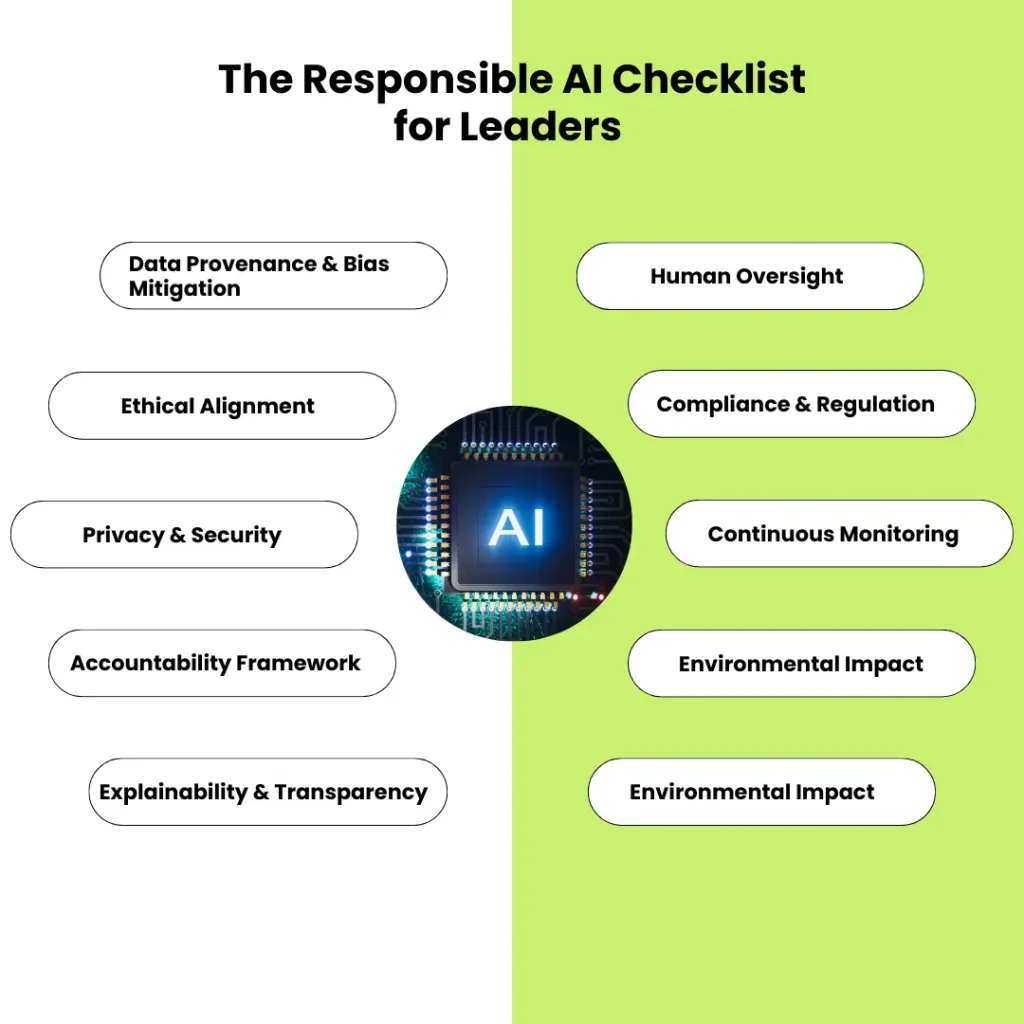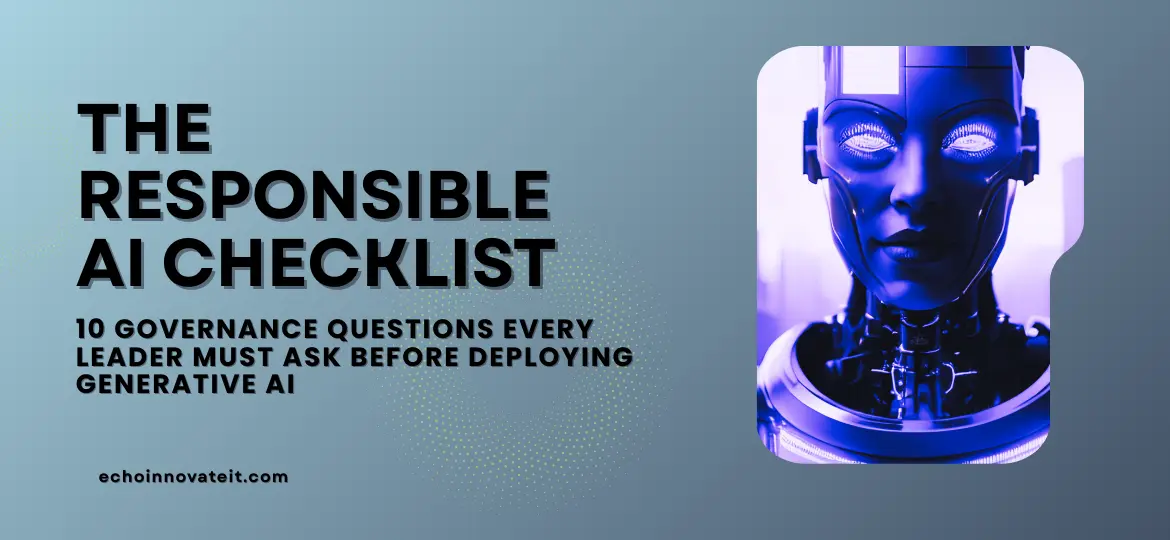10 Governance Questions Every Leader Must Ask BeforeDeploying Generative AI
Generative AI is one of the fastest-growing technologies in the USA, transforming industries like healthcare, finance, education, and retail. From automating workflows to generating creative content, it’s redefining the way organizations operate. But without a responsible AI checklist, leaders risk exposing their businesses to legal, ethical, and reputational damage.
According to McKinsey’s research, 44% of organizations have already faced negative consequences from unmanaged AI risks. These risks include data bias, intellectual property infringement, privacy violations, hallucinations, and even workforce displacement. With the U.S. market for generative AI projected to hit $442.07 billion by 2031, the pressure on leaders to prioritize ethical AI deployment has never been higher.
That’s where a Generative AI governance checklist comes in—helping businesses build safe, compliant, and transparent AI systems.
Why Responsible AI Matters for U.S. Businesses

According to McKinsey, over 44% of organizations have already faced negative outcomes due to unmanaged AI risks.
From inaccurate outputs to intellectual property infringement, privacy violations, and even workforce displacement—
the consequences are real. With the U.S. AI market projected to grow to $442.07 billion by 2031
building ethical, compliant, and secure AI systems isn’t optional anymore—it’s a necessity.
Key Factors for Choosing the Best AI Plugin

1. Data Provenance & Bias Mitigation
Ensure training data is sourced ethically, diverse, and bias-free. Poor data governance can lead to inaccurate
and discriminatory outputs. U.S. enterprises must adopt robust data lineage tools and audits to guarantee fairness.
2. Ethical Alignment
Generative AI must align with organizational values. Establish AI ethics charters and internal boards
to ensure fairness, inclusivity, and transparency.
3. Privacy & Security
Sensitive data breaches can cost millions. Secure encryption, access controls, and compliance with
U.S. privacy laws (CCPA, HIPAA, FTC guidelines) are essential.
4. Accountability Framework
Who is responsible if AI goes wrong? Clearly define ownership—from developers to executives—so
accountability is never in question.
5. Explainability & Transparency
Customers and regulators demand clarity. Use Explainable AI (XAI) tools like SHAP or LIME to
show how AI decisions are made. Transparent logs build consumer trust.
6. Human Oversight
AI should augment—not replace—human decision-making. Establish human-in-the-loop workflows
with escalation points to prevent blind reliance on AI systems.
7. Compliance & Regulation
From the EU AI Act to evolving U.S. regulations, compliance is crucial. Regular audits, documentation,
and monitoring regulatory updates safeguard organizations against fines and legal disputes.
8. Continuous Monitoring
AI isn’t “deploy and forget.” Monitor performance for drift, anomalies, and fairness degradation.
Regular retraining and auditing ensure consistency.
9. Environmental Impact
AI training consumes vast energy. U.S. enterprises must prioritize green AI strategies—using
efficient models and sustainable infrastructure.
10. ROI of Responsible AI
Responsible AI isn’t just about avoiding risks—it’s about driving growth. Companies that
prioritize ethics and compliance see stronger customer trust, reduced costs, and long-term
competitive advantage.
Key Benefits of a Responsible AI Strategy

- Increased customer trust and loyalty in U.S. markets.
- Stronger brand reputation with ethical AI adoption.
- Reduced compliance risks with evolving federal regulations.
- Improved operational efficiency with ethical automation.
- Long-term sustainability with energy-efficient AI models.
Emerging U.S. Trends in Generative AI Governance
- Agile 5Ws Framework (Who, What, When, Where, Why) offers adaptable AI policy-making.
- Data readiness is now the foundation for successful AI deployment—clean, governed, and secure datasets
are non-negotiable. - Cross-industry adoption: Healthcare, finance, retail, and legal industries are leading AI governance models
to ensure safety and fairness.
Final Thoughts
Generative AI is a double-edged sword—it drives growth and innovation but can also introduce unforeseen risks.
By following this Responsible AI Deployment Checklist, U.S. businesses can minimize risks, align with compliance,
and build trust among customers. The ROI of responsible AI goes beyond compliance—it ensures long-term resilience,
customer retention, and sustainable growth.
If your business is ready to embrace responsible AI, partner with experts like Echo Innovate IT to design
AI systems that are ethical, compliant, and tailored for the U.S. market. Let’s build the future of AI responsibly.
The Responsible AI Checklist: 10 Governance Questions Every Leader Must Ask Before Deploying Generative AI
What is the Responsible AI Checklist?
It’s a set of governance-focused questions designed to help leaders assess the risks, ethics, and accountability measures before deploying generative AI solutions in their organizations.
Why do leaders need governance questions before deploying AI?
Generative AI can create value but also carries risks like bias, misinformation, privacy violations, and regulatory non-compliance. Governance questions ensure that leaders proactively identify and mitigate these risks.
What kinds of governance questions are included in the checklist?
The checklist typically covers 10 key areas such as data integrity, bias and fairness, transparency, accountability, compliance, human oversight, security, explainability, alignment with organizational values, and impact monitoring.
Who should use the Responsible AI Checklist?
It’s designed for C-suite executives, data and AI leaders, compliance officers, and policymakers who are responsible for making strategic decisions around AI deployment.
How does the checklist help organizations stay compliant?
By systematically addressing governance questions, leaders can align their AI practices with evolving regulations (e.g., EU AI Act, U.S. AI guidance) and industry standards, reducing legal and reputational risks.



